Salem Ave is a major thoroughfare in northwest Dayton with a fascinating history (this article covers Longfellow School, the Miller Building, and more), a more recent history of disinvestment and struggle, and exciting plans for the future.
The Gem City Market aims to bring a full-service co-op grocery store to one of the Dayton region’s largest food deserts, and the project is well on its way. As of Fall 2018 it had amassed close to 2,000 members as well as $2.5 million in donations from the likes of CareSource, Dayton Children’s, Kettering Health, and KeyBank.
The capital campaign was completed in late 2019 and construction began soon after. The coronavirus pandemic has slowed things down somewhat but work has continued with an opening date planned for 2021.
The site of the market is on the 400 block of Salem Avenue in the Old Dayton View neighborhood. A major entryway into downtown Dayton, Salem also serves as the western boundary for Grafton Hill as it moves northward. It then bisects several other northwest Dayton neighborhoods before continuing into Trotwood.
Salem Ave was originally Salem Pike, an early trade route between Dayton and a small town named Salem, later absorbed into Clayton.
History of Dayton View Neighborhood and Salem Ave
Unlike other early Dayton neighborhoods like Huffman, Old North Dayton, Riverdale, and the West Side (Wright-Dunbar), Dayton View–with Salem as its primary thoroughfare–was not a self-sufficient complete neighborhood filled with retail shops, businesses, churches, and other everyday needs.
Instead it was a residential bedroom community suburb for the wealthy, who traveled downtown on the Dayton View Street Railway starting in 1871. Eventually more than just homes would be built, such as churches and schools, and in the 1920s it “began to lose some of its residential purity, (and) a small amount of commercialism appeared,” mostly around the intersection of Salem and Grand Avenues. Business development would gradually grow, turning Salem into a bustling commercial area.
The Salem Ave Peace Corridor, an organization aiming to “promote and unify the communities, residents, businesses, and institutions along the Corridor,” described the area’s subsequent decline during the latter parts of the 20th century:
As people migrated to the suburbs, disinvestment occurred along the Corridor, and vacant houses and businesses appeared … A lower population, and competition from shopping malls in outlying communities, reduced the support for businesses along the corridor. Housing prices in area neighborhoods declined as vacancy rates grew. Some of the housing stock deteriorated. Consumer preferences for housing have changed, challenging the area neighborhoods to attract new homeowners and investment as needed to thrive.
Many are optimistic about the future with projects like Peace Corridor and the Gem City Market, even with major anchor Good Samaritan Hospital’s departure taking away 1,600 jobs.
Lower Salem Ave near the future site of the market has changed greatly over the years, but several historic landmarks remain. Let’s take a look at some of them.
Longfellow School (1882): History and Redevelopment
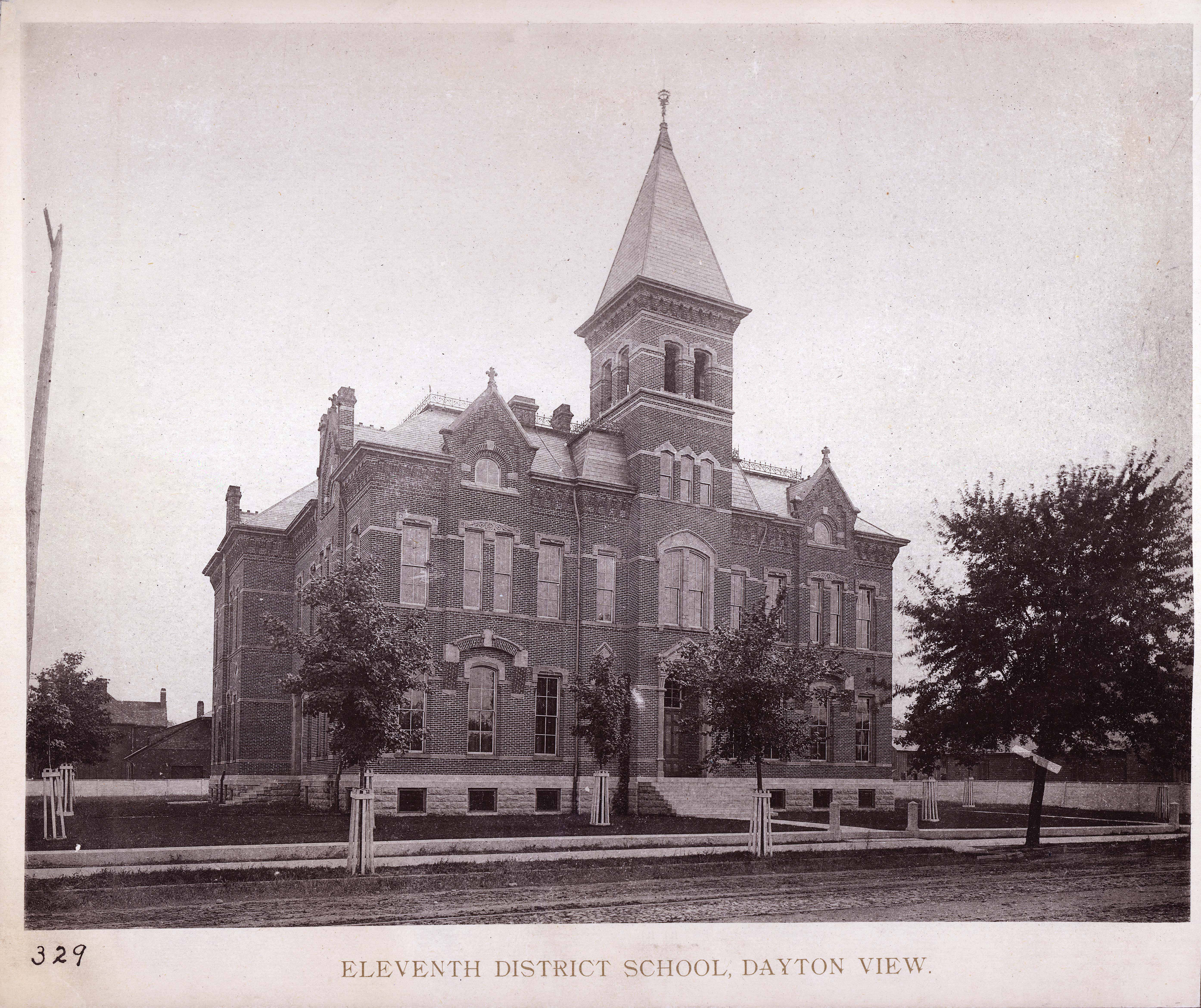
One of the first non-residential buildings to spring up in the Dayton View/Grafton Hill area was this school built in 1882. It was first known as the 11th District School before being renamed Longfellow School in 1904.
It is late Victorian in style, with an “irregular floor plan, decorative cornice detailing and large rectangular windows with decorative stone incised surrounds.”
For many decades it would serve the children of Dayton View, but structural problems including roof leaks and falling bricks led to its closing for the 2017-18 school year.
It’s been identified as a target for potential redevelopment and in early 2020 was purchased by G.F. Bailey, a “local impact investing firm that connects investors with projects targeting “socially responsible change.”
The company’s plans include an adaptive reuse project involving market-rate housing units and possibly a restoration of the school’s theater and an aqua-farm operation in conjunction with the Gem City Market that sits just across the street.
Miller Building (1926) (Lebensburger’s Drugs, Salem Theater)
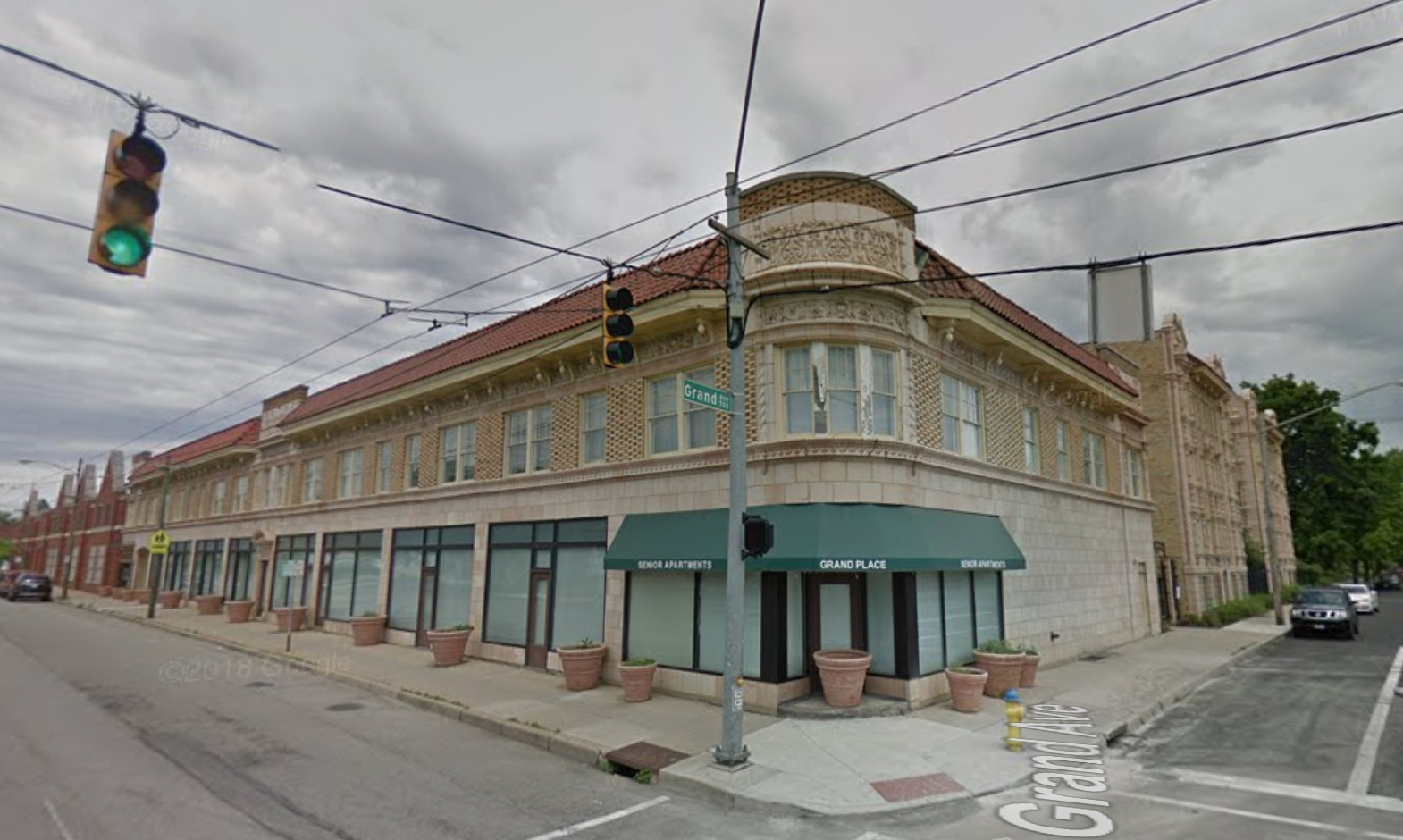
When commercialism began to creep into Dayton View/Grafton Hill in the 20s, this ornate structure was the centerpiece. The Miller Building and the adjacent Delux Apartments, all built in 1926, are “without a doubt the most outstanding terra cotta structures in the city of Dayton.”
The Miller Building features numerous storefronts on Salem and also curves around to face Grand Avenue. Tenants over the years included the popular Lebensburger’s Drugs on the corner, which was operated by Issac (Ike) Lebensburger and featured a pharmacy as well as a soda fountain serving lunch.
Household items, candy, cigars, magazines and comic books were also for sale. That business closed in 1947 but the location remained a drug store for a while afterwards.
The building also housed as the Salem Theater at 521 Salem from 1928 until 1965. The theater space was later converted by Vic Cassano of Cassano’s fame into a restaurant called Tyrolen Village and a delicatessen.
Today the upper floors have been converted into senior apartments.
Dayton Jewish Chronicle / Dayton Weekly News (1864)
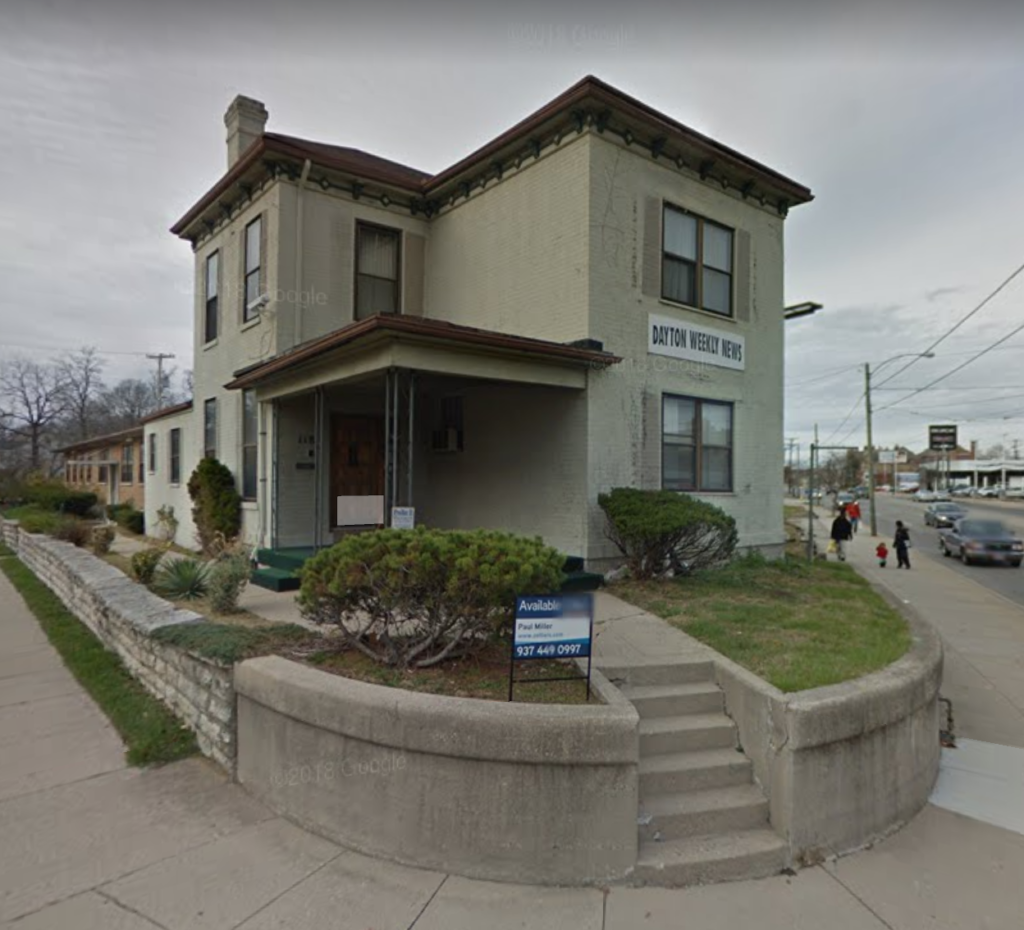
An early residence converted to an office building, this structure at 118 Salem Ave has been the home of two newspapers: first the Dayton Jewish Chronicle and later the Dayton Weekly News which primarily serves the African-American community.
Dayton Weekly News publisher Don Black moved his newspaper’s offices from the Centre City Building downtown to 118 Salem in 2006.
Around that time the structure also housed the administrative offices of the Omega Baptist Church. (As an aside, that church previously took over the former Temple Israel farther up Salem at 1821 Emerson Ave, another historic structure built in 1925.)
The original house dates back to 1864 according to county property tax records. As of 1899 it was the home of a Mrs. W. F. Geiser.
The building is circled in red below on a 1897 map alongside a couple of long-lost neighborhood companies: the Schwind Brewing Company and Winegartners Slaughterhouse.
The area near the river here looked radically different before the Miami Conservancy District’s flood control plan was implemented, and you can see how the area south of River Street (all demolished today) was largely commercial, in stark contrast to the elegant Dayton View homes a few blocks north. (Click the image to enlarge)
For comparison, roughly the same angle today with the same building circled:

A bonus cool Lower Salem Ave building is the old condo or rowhouse structure below that was built in 1900, a rare building type for the Dayton area.
You can see in the above map from 1897 that is hasn’t been built yet, as it would replace the smaller structure on the Salem and River intersection.

Hopefully some new construction will soon join these historic Salem Ave buildings to help it transition back into a thriving corridor for northwest Dayton.
Sources:
Dayton school closes after leaky roof goes unfixed for 14 years
Dayton in the 20th Century. Tom Dunham. Authorhouse (2005).
Dayton Through Time. Curt Dalton. Arcadia (2015).
When Dayton Went to the Movies. Curt Dalton. (1999).
Grafton Hill Historic District. National Register of Historic Places Nomination Form

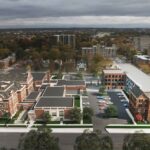
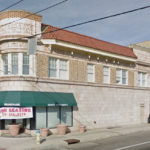
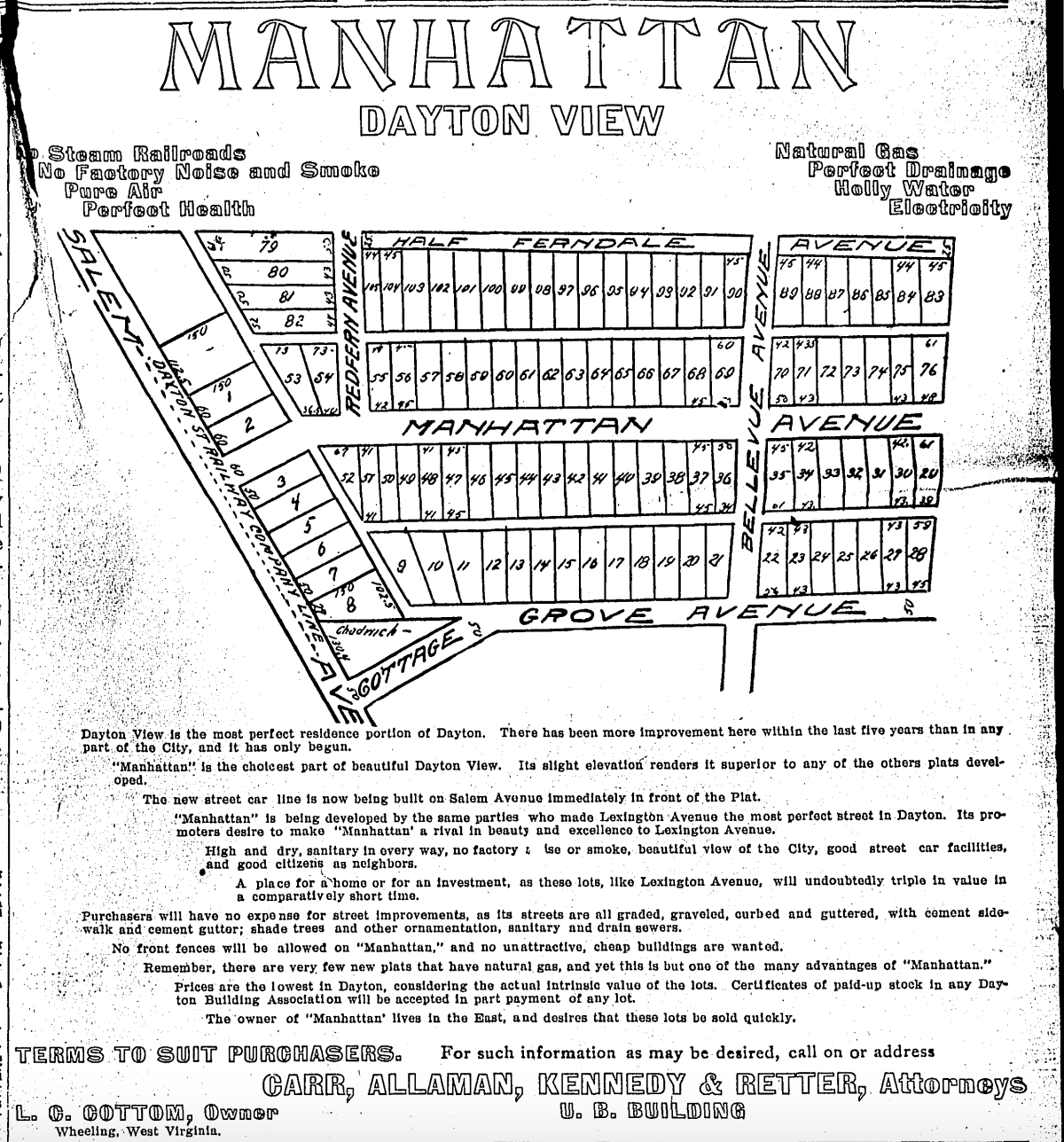

Andrew,
Dayton View was not just filled with churches, per se. By the mid-20th Century, it was a neighborhood of three Synagogues (Beth Abraham, Beth Jacob, and Temple Israel), hence the existence of the Dayton Jewish Chronicle on Salem Avenue. There was, too, a sharp distinction between Lower Dayton View and Upper Dayton View. The “lower” neighborhood was largely working class, while the “upper” included doctors, lawyers, and captains of industry and retail. There were Jewish families, in particular, who migrated from lower to upper as success prevailed. The neighborhood became sharply less Jewish beginning in the mid-1980’s, and a total of four “schuls” (synagogues) moved out of the neighborhood to other locations of the city by the 90’s – the most prominent being Temple Israel which is now located on Riverside Drive. The neighborhood lastly lost Beth Abraham’s magnificent stained glass windows at Salem and Cornell which have now been partly restored in the congregation’s new Sugar Camp (NCR) location. All the the sanctuary buildings have now seen other uses.
When I think of Dayton View and so much of Salem Avenue, I know a sense of “home” is still encoded in it. Driving from Good Samaritan Hospital (soon lost) toward Downtown, one used to pass many good places: Steve’s Cycle Shop, Ken McAllister’s Art Shop, Baskin Robbins, The Dayton Theatre Guild, Carlin Audio, Sully’s, Salem Camera, and on and on. I’m glad some of the neighborhood, particularly on the Salem corridor, is grudgingly breathing back into life, and I’m thrilled about the Gem City Market possibilities.
Thanks for sharing that history and the information about the synagogues and other businesses! Since this piece was getting long I thought I’d make the Jewish community history its own post and link them together, but if I don’t get around to that soon I’ll just recommend “Jewish Community of Dayton” by Marshall Weiss for any curious readers. Interestingly, someone just asked on Facebook about old synagogues on Wayne so that got me researching Beth Abraham (first occupying the SE corner of Wayne and Fifth, and later at 530 Wayne).
I also think digging more into Upper Dayton View would make an interesting future article too. I haven’t read a whole lot about the area during the time period you mention.
Very good, Andrew!
Actually, the Wayne Avenue Schul, as it was casually known (officially the predecessor of Beth Abraham on Salem and now at the Sugarcamp complex on the Dayton/Oakwood border) was a local legend – giving rise to one of the most celebrated Rabbis in the United States – Samuel Burick, father of Si Burick the celebrated Dayton Daily News sports columnist who was inducted into the Baseball Hall of Fame. My maternal great grandfather died walking to sabbath services there on a Saturday in 1936.
I’d challenge you to find any decent interior or exterior photographs of this temple, as they are most rare!
I grew up in Dayton in the fifties and sixties and remember it as a vibrant blue collar working town.. In high school at JH Patterson Coop , one job I had was at Dayton Blueprint Company on Patterson boulevard. My job was to ride a bicycle to pick up and deliver prints all over the downtown area. Later I worked at Hayes Tool Supply on McCook avenue and I drove a company vehicle all over town and the suburds deivering machine tools to businesses like Inland, Harris Seybold, McCalls, Delco, GHR Foundry, and NCR., and many other small machine shops around the Dayton area. I thoroughly enjoyed Dayton, it was a great time and place to be growing up.
I also went to Patterson Co-Op High School and graduated in 1970. I took Drafting there and co-oped at Frigidaire in their
Tool Design department .I t was excellent training for a high school student and led to 32 years employment at General Motors in Dayton. It was a wonderful city to grow up in!
Does anyone have any history on Steve’s Cycle Shop? I have an interesting old Czech bicycle(brand Favorit) that has their logo and I’d like to know more.
Hey… 2 years later.
I used to work at Steve’s… and I am still riding my Favorit. I can probably answer some questions
When I was having some work done on my back porch, I found some papers under the porch. One of the papers was a list of names (all women) and dues (25 cents a month) that each person paid. I looked up the organization’s name that was on the top of the paper. It was something like an African American Freemason group for women. Before I started renovating the home there was a large room on second floor with a stage.
Would you know anything more about the organization? My address is 645 Superior Avenue – 1 1/2 blocks from Salem.
Hello Patricia,
I am responding to your note concerning the papers you found under your porch
and your home once having a large second floor room with a stage. I am a Black
Historical Architect from Dayton. I have written about Dayton’s Black women and their organizations. I would be happy to share information with you.
Hello Dave,
I just found your response today. If you can still offer any information I would be very grateful! Although I just sold the home, zIm still interested in it’s history, not only for myself but also for the new owners. I can also provide you with a few items I have such as architectural drawings for Phase I-III renovations as well as before and after photos.